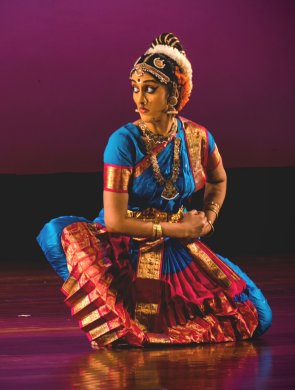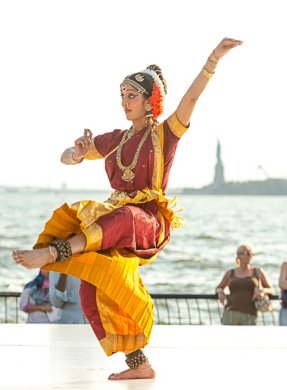
|
 |

|
 |
Yamini Saripalli: Doctor and dancer - Bhavanvitha Venkat e-mail: bhavanvitha@gmail.com Photos courtesy: Yamini Saripalli June 4, 2015  US based Yamini Saripalli is a Kuchipudi dancer trained under legendary Kuchipudi guru Dr. Vempati Chinna Satyam. She is a regular performer in both the US and the Chennai Marghazi Season. At present she is learning from Vempati Ravishankar, son of Dr Vempati. Yamini is a practicing physician as well. She also organized several dance programs for charitable organizations. Being a direct student of an illustrious guru who shaped the art form to the entire world and whose choreographies continue to attract more students from different walks of life, I felt that her dance and her thoughts would prove to be useful for many a Kuchipudi dancer. Yamini, please let us know how your dance life started. I come from a family of doctors and engineers. But then, I have always loved music from my childhood. My mother says that I would make my parents record songs with certain ragas I liked so that I could listen to them over and over. Any kind of music has always moved me to dance. My introduction to Kuchipudi was through my first dance teacher Sujatha Vinjamuri in my home town of St. Louis, Missouri. I then seriously started learning Kuchipudi in high school after being inspired by my guru's dance drama Hara Vilasam. Once I started learning under Master and his son Vempati Ravi Shankar, I knew that this was what I wanted to pursue for my lifetime and from that point on, I have never looked back. Dr Vempati Chinna Satyam is a legend and we all know that he spread Kuchipudi to the entire world. Having learnt from such an illustrious person, you certainly would have observed him closely. Can you share some notable incidents, observations about him that made a huge impression on your thinking? There are many incidents with Master that have left an indelible mark on my mind. But more importantly, the principles that he led his life with had the largest impact on his students. 1. Humility. Master always used to mention that he was only a drop in the ocean of art and that he had so much to do for the art and so much to learn during this lifetime. He respected all art forms and saw the beauty in all art. He did what he did because he loved it so much and felt so passionate about it. If people would bow down to him, he would ask them to not bow to him but to bow and respect the art form and support it, because he always saw the art as much bigger than himself. 2. Commitment and dedication: Master lived his life for the art alone. He never charged any student a single rupee in his entire lifetime. The only things that he asked from students were daily class attendance, hard work and sincerity toward the art. Though he was strict and disciplined, if the students showed interest, dedication and purity of heart, he always encouraged them. In terms of choreography and productions, he would choreograph in the early hours of the morning and production rehearsals would often go towards the middle of the night. He often would go on only a few hours of sleep. He would say that in life, obstacles will come in our way because that's how life is, but in spite of that, we should keep going, and that's the only way we can do something for the art. 3. Karma yoga: Master never sought or even wanted awards for his brilliant work and service to the art form. He always felt that in whatever we do in life, we should do it with a hundred percent effort, focus and passion, and the result was not up to us. If recognition came, that was fine, and if it didn't come that was also fine. But that our job as human beings was to just do our duty in whatever job we did, to our full capacity. Dr. Vempati Chinna Satyam's productions stood for meticulous planning into details. His choreographies are known for their beauty and exquisite quality. You must have performed the wonderful items he created on many stages. Tell us about the performances that are most satisfying. The most satisfying performances for me are ones that I know I have done my best, improved from my previous performance, and felt, if even for a moment, that I was a mere instrument for the art to flow through... and therefore, there was no Yamini on stage, there was just Kuchipudi. We all strive for that as artists, but that transcendence of the body requires great concentration and is very challenging to achieve in each performance.  You are into a busy profession, how do you manage both dance and work? Especially these days we often hear that dancers stop performing after their arangetrams and rangapravesams... so I feel there must be a deep motivating factor for doing both. Something about that..? I believe to achieve anything in any field, three qualities are necessary. 1) Passion. 2) Clarity of thought and 3) Hard work. I knew from the day I started learning under Master that no matter what came my way in life, one thing was for sure. I would dance everyday for the rest of my life, and that I knew without a shadow of a doubt. Once that clarity of thought was there, I was always able to make it work with my medical profession though it was often challenging and exhausting. And that is because I had the clarity of thought of what I wanted and was willing to work hard even through medical school, rotations and residency, because to me, dance was always my priority and still is. It grounds me and brings me an inner peace that nothing in the outside world can do. We see a vibrant dance culture happening in the US, so your thoughts about Kuchipudi in the US? Every teacher has their individual way of teaching. But I feel there should not be any compromise or lower standards just because one is teaching in the US. In my opinion, teachers should teach with the same standard that they were taught by their gurus. Master taught us so much beyond dance through the way he led his daily life and conducted his classes. Though it may be challenging, I feel that these cultural nuances especially reverence for the classroom and the art as well as disciplined practice, should also be taught to the students who are learning in the United States. These are the nuances in my opinion that help to create a strong guru sishya relationship as well as help students continue dancing or be involved with dance throughout their life. I also hear that you participate actively in social work through your dance and that you have been doing this since many years. Do let us know more about it. Both Master and Vempati Ravi Shankar have always been an inspiration not only in dance but in terms of helping those in need. It was Master's dream to build a hospital with a full serviced medical clinic in the village of Kuchipudi. He fed all of us students free of cost when we stayed there for months at a time, and no one could ever leave his house without drinking coffee and eating something. He often financed medical procedures for students' families who were in financial need. Vempati Ravi Shankar has a long standing association with the Tamil Nadu Kidney Research Foundation, an organization that provides subsidized and free dialysis, kidney transplants and medications to underprivileged individuals in Tamil Nadu. He has conducted several fundraising dance programs for this organization. Being inspired by this, I have also organized a few fundraising dance programs with other dancers to benefit the Tamil Nadu Kidney Research Foundation. That's inspiring work, Yamini. Now tell us about what you would like to achieve in your dance... A lifetime is not sufficient for learning one art form. I wish to always continue learning. My annual trips to Chennai are not only for performing, but also to continue the learning process under my guru Vempati Ravi Shankar. The beauty of this art journey is that there's always scope to improve and always more to learn. And if one truly loves art and is passionate about it, this journey will always be enjoyable. I would like to continue to perform but also focus on lecture demonstrations and educating audiences. In addition, one of my primary goals is to teach Kuchipudi to the next generation in an atmosphere that fosters learning art for the sake of learning art and as part of their education. Children should learn art because they love it. I want to encourage quality over quantity. I want my students to have a strong foundation grounded in fundamentals. The students may learn less items but they will be very thorough and at a high standard for the items that they do know. Though every student may not become a performer professionally, I want all my students to learn at a high standard, learn to value the art and always have their art within them to enrich their lives. What is your favorite stage? My favorite stage is the classroom dancing in front of Master. It's a totally different world where one loses oneself in the art. Which dance style do you love to watch? I love to watch Odissi dancing, so much grace and control are a must for this dance style. My favorite piece in Odissi that I have seen is Sujata Mohapatra's Jataayu Moksham. She embodies each character so well that you feel that the Ramayanam is happening right there in front of you. Any suggestions for young dancers? Find your passion in life, have clarity of thought, be dedicated and work hard. Don't look for the result but enjoy doing what you do. You can achieve anything in life with these principles, and especially the most important thing in my opinion is inner peace. Contact Yamini: yamini.saripalli@gmail.com Post your comments Unless you wish to remain anonymous, please provide your name and email id when you use the Anonymous profile in the blog to post a comment. All appropriate comments posted with name & email id in the blog will also be featured in the site. |